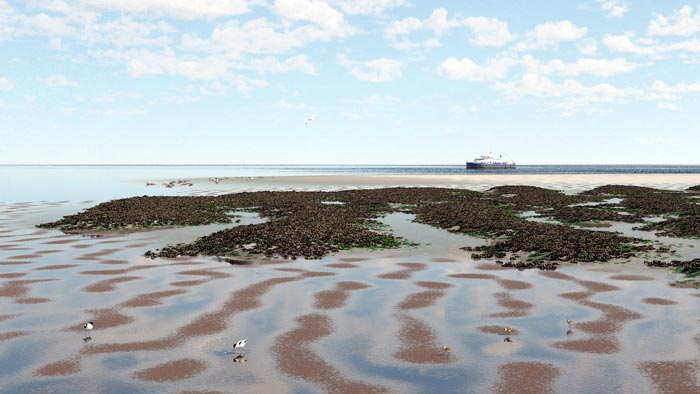Climate change tipping points: back to the drawing table

Spatial pattern formation of mussels and diatoms on a tidal flat. This pattern formation allows tipping points caused by sea level rise to be evaded, so that tidal flats do not drown. The spatial patterns on the tidal plate, including the waves, are based on mathematical model simulations.
Credit
Johan van de Koppel / Ulco Glimmerveen (birds).
We regularly hear warnings that climate change may lead to ‘tipping points’: irreversible situations where savanna can quickly change into desert, or the warm gulf stream current can simply stop flowing. These cautions often refer to spatial patterns as early-warning signals of tipping points. An international team of ecologists and mathematicians has studied these patterns and come to a surprising conclusion. “Yes, we need to do everything we can to stop climate change”, the authors said in full agreement with the recent IPCC report. “But the earth is much more resilient than previously thought. The concept of tipping points is too simple.” The scientists have recently published their work in the authoritative journal Science.
The article builds on years of collaboration between a variety of research institutes in the Netherlands and abroad, especially between Utrecht University and Leiden University. The researchers approached the idea of a tipping point within a spatial context. “The formation of spatial patterns in ecosystems, like the spontaneous formation of complex vegetation patterns, is often explained as an early-warning signal for a critical transition”, explains lead author Max Rietkerk, ecologist affiliated with Utrecht University. “But these patterns actually appear to allow ecosystems to evade such tipping points.” These findings are based on mathematical analyses of spatial models and new observations from real-world ecosystems.
Alan Turing
Spontaneously emerging patterns in nature are often referred to as ‘Turing patterns’, named after the renowned British mathematician Alan Turing. In 1952, he described how patterns in nature, such as the stripes on animals’ coats, can develop from a homogeneous starting position. “In ecological science, the Turing patterns are often explained as early-warning signals, because they indicate disturbance ”, clarifies Leiden University mathematician and co-author Arjen Doelman. “Turing’s mechanism of pattern formation is still undisputed. But the fact that a pattern is forming somewhere does not necessarily mean that an equilibrium is disrupted beyond a tipping point.” As an example of such a situation, Rietkerk refers to the transition from savanna to desert. “There you can observe all sorts of complex spatial forms. It’s a spatial reorganisation, but not necessarily a tipping point. On the contrary: those Turning patterns are actually a sign of resilience.”
Evading tipping points
The researchers discovered an interesting new phenomenon in ecology: multistability. It implies that many different spatial patterns can occur simultaneously under the same circumstances. Rietkerk: “And each of these patterns can remain stable under a wide range of conditions and climate change. And moreover we found that any complex system large enough to generate spatial patterns may also evade tipping points.” The question now is: which systems are sensitive to tipping, and which are not? “That means we have to go back to the drawing table to understand the exact role of tipping points”, Rietkerk says. “Only then can we determine which conditions and spatial patterns result in tipping points, and which ones do not.”
This work contributes to the TiPES project, an EU Horizon 2020 interdisciplinary climate science project between 18 partner institutions in 10 European countries on tipping points in the Earth system.
Journal: Science
DOI: 10.1126/science.abj0359
Method of Research: Computational simulation/modeling
Subject of Research: Not applicable
Article Title: Evasion of tipping in complex systems through spatial pattern formation
Article Publication Date: 8-Oct-2021
Original Source
All latest news from the category: Ecology, The Environment and Conservation
This complex theme deals primarily with interactions between organisms and the environmental factors that impact them, but to a greater extent between individual inanimate environmental factors.
innovations-report offers informative reports and articles on topics such as climate protection, landscape conservation, ecological systems, wildlife and nature parks and ecosystem efficiency and balance.
Newest articles

Innovative 3D printed scaffolds offer new hope for bone healing
Researchers at the Institute for Bioengineering of Catalonia have developed novel 3D printed PLA-CaP scaffolds that promote blood vessel formation, ensuring better healing and regeneration of bone tissue. Bone is…

The surprising role of gut infection in Alzheimer’s disease
ASU- and Banner Alzheimer’s Institute-led study implicates link between a common virus and the disease, which travels from the gut to the brain and may be a target for antiviral…

Molecular gardening: New enzymes discovered for protein modification pruning
How deubiquitinases USP53 and USP54 cleave long polyubiquitin chains and how the former is linked to liver disease in children. Deubiquitinases (DUBs) are enzymes used by cells to trim protein…



